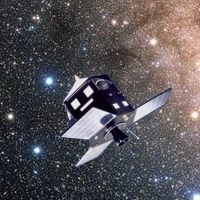A New Reduction of the Hipparcos Catalogues
27 September 2007
ESA's Hipparcos mission provided astrometric data on thousands of stars. Thanks to advances in computational processing power it has been possible to revisit the original data and improve the accuracy of the derived catalogue.The accuracy of a data set, such as the Hipparcos astrometric data, is generally determined by two contributions: intrinsic, random, noise and modelling noise. The latter represents contributions from inaccuracies in the models used to calibrate and reduce the data. In the original Hipparcos catalogue published in 1997, the noise on the data for all stars brighter than about magnitude 9 is to some extent dominated by modelling noise. This noise contribution originated from the difficulty in reconstructing the reference frame with respect to the orientation and rotation rates of the satellite. Such modelling errors, unfortunately, also tend to produce errors that are correlated between neighbouring measurements, so that results become rather uncertain when combining data - as in the case of stars in a cluster.
 |
|
Artist's impression of Hipparcos |
A few scan-phase jumps had been observed during the original Hipparcos reductions, but they were considered to be unimportant overall. In a detailed analysis of the data around 1600 of these jumps were identified. In the same analysis, some 80 small hits were detected. Typically, a detected hit would be the equivalent of changing the rotation rate of the satellite by one full rotation in two years, but for an astrometric satellite, such changes are very significant.
A new approach to the reconstruction of the attitude was prepared and extensively tested. It effectively reconstructs the underlying torques, and derives through integrations the rates and orientations as a function of time. This approach made it very simple to incorporate provisions for scan-phase jumps and hits. The first complete reduction of the data using this approach showed that noise levels on the attitude reconstruction could be brought down by up to a factor five compared to the original reductions and made the intrinsic measurement noise the dominant noise for all stars fainter than about magnitude 4. At this point it was decided to do a complete re-reduction of the Hipparcos astrometric data; having available the raw data, the software and the knowledge of the mission, no other choice seemed to be possible.
The final reductions have used the same approach as is planned for the Gaia mission, iteration between the reconstruction of the along-scan attitude and the construction of the final catalogue. Both processes use the same data, but in a very different way. Special care was taken to avoid problems with parts of the sky where there are a lot of bright stars concentrated over a small area. In the end, 15 iterations were made, after which the system appears to have converged.
There are many examples of the improvements in the new reduction data. The highest accuracy parallaxes have formal errors of 0.09 mas, compared to 0.5 before. Distances of open clusters are 2 to 3 times more accurate (and more reliable) than as obtained from the 1997 catalogue. Some 1000 stars for which the original reduction could not find a solution are now solved for without a problem, and the original problems can be traced down to accidental accumulations of modelling errors in the attitude. The reliability of the new data is evident in the occurrence and distribution of negative parallaxes which is also an indication of the formal errors on the data.
The revised catalogue is included with a book on the new reduction, which also describes in detail the proper use of such data in a wide range of applications [Hipparcos, the New Reduction of the Raw Data, published by Springer]. The catalogue will also go on-line in early 2008 through Astrogrid, where it will also be maintained.
The data reduction work was carried out at the Institute of Astronomy of the University of Cambridge by Floor van Leeuwen.
